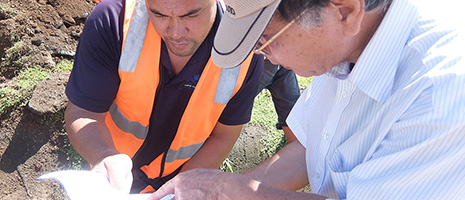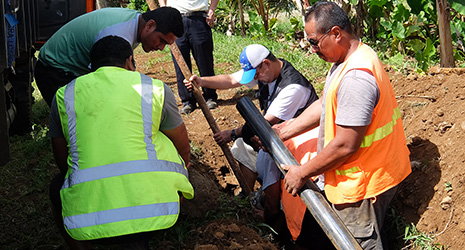Home > Highlighting JAPAN > Highlighting Japan January 2017 > Safety First
Highlighting JAPAN


Water Wisdom Shared
Water experts from Okinawa are introducing water supply technologies to the Polynesian islands of Samoa.
In Japan, where the water supply service is operated by approximately 1,700 municipalities, people everywhere have access to clean drinking water simply by turning on the tap. Many Japanese municipal water service providers have been sharing their water supply knowledge and expertise with other countries. Okinawa, a subtropical archipelago of approximately 160 islands where water resources are limited, is one example.
Miyako-jima island in Okinawa Prefecture, which has no river and depends on groundwater for most of its water resources, has introduced a system that does not rely on chemicals to protect the natural environment. The Ecological Purification System creates non-turbid water free of bacteria by allowing the water to pass through a film of microbes grown on the sand surface which traps bacteria and decomposes dissolved solids to some extent as the water passes slowly through the sand filter. The system, which features low cost and easy-to-maintain operation, is considered to be an effective water purification method in subtropical and tropical areas, where biological activity is strong.
Taking advantage of technologies such as these that it has nurtured locally, Okinawa has been providing continuous assistance with the water supply service to Samoa, an islands state with a similar climate to its own in the South Pacific, in cooperation with the Japan International Cooperation Agency (JICA). In Samoa, a country comprising two large and several smaller islands, the water supply service is operated by the Samoa Water Authority (SWA), which provides water to 85% of its total population, approximately 160,000 people. However, the SWA faces a variety of challenges including certain unachieved water quality standards as well as a high non-revenue water ratio. Non-revenue water is produced water for which a supplier cannot bill for reasons such as water leakage, inaccuracy of customer meters or water theft.
The water supply unit of the aforementioned Miyako-jima City in Okinawa has been providing assistance with the strengthening of water treatment operation capacity of its Ecological Purification System since 2006. In addition, the Capacity Enhancement Project for Samoa Water Authority in Cooperation with Okinawa (CEPSO), a five-year technical cooperation Project supported by JICA, kicked off in 2014 with the participation of experts from several water service providers in Okinawa Prefecture. In the Project, technical cooperation is underway in the Alaoa water supply scheme, which provides water to the central area of Apia, the capital.
One of the major objectives of the Project is to decrease the non-revenue water ratio, which was 68% when the Project commenced. Various measures have been implemented under the Project. One of these is the improvement of the accuracy of a computer-based geographic information system (GIS) that centrally manages information such as pipeline positions and locations where water meters are installed. This has contributed to some effects such as identification of places of leakage and identification of pipeline and valve positions at the time of repair and renewal.
“SWA staff members carried copies of the water distribution map and went around the island to inspect the spots where leakage was occurring, as well as the customer meters,” says Motomu Takara, who participated in the Project as chief adviser from its start until December 2016. “As a result, we found that there were some unregistered customers in the customer list. These efforts significantly improved the accuracy of the map.”
Many experts are dispatched from Okinawa on a short-term basis to work with SWA staff members on operations such as pipeline construction, plumbing, water distribution management, leakage detection, water leakage repair and water quality monitoring. As part of the Project, SWA staff members have also been invited to Okinawa on two occasions for workshops on the maintenance of water supply facilities and countermeasures for non-revenue water. The staff members held briefing sessions after their return from Okinawa to share their knowledge and skills with the other members of the SWA.
As of 2016, the ratio of non-revenue water had fallen to 55%.
“In Japan, water supply development is undertaken based on a forecast for twenty to thirty years down the road. We stressed the importance of acting from a long-term perspective in Samoa and consequently the SWA moved forward with efforts to undertake various improvements of facilities,” says Takara. “Thanks to the effective water leakage control, water pressure is maintained at an appropriate level. Showers, which were previously weak, can now be used comfortably.”
A variety of countermeasures were also taken regarding the unachieved water quality standards. These included measurement of the required amount of chlorine, maintenance of the equipment that adds chlorine to water, and maintenance of water treatment plants. Consequently, the water quality rating, which had previously stood at only 50% to 60% of the required level, has improved to 100% (as of October 2016).
The Japanese Grant Aid Project for Improvement of Urban Untreated Water Supply Schemes was also implemented. Under the Project, the installation and replacement of water intake facilities and water pipes, and the construction of new water treatment plants, among other works, were carried out in three water supply districts on the outskirts of Apia, and have made a significant contribution to achieving a safe, stable water supply.
“Nothing makes us happier than seeing SWA staff members collaborating and working proactively on challenges,” says Takara. “We are starting to witness the achievements of human resource development, one of the important objectives of the Project. We expect that these achievements will spread to other areas covered by the Project going forward.”
© 2009 Cabinet Office, Government of Japan






